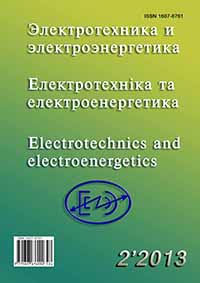ANALYSIS OF HARMONIC COMPOSITION OF THE ALTERNATING MAGNETIC FIELD ASSOCIATED WITH THE ROTATING ROTOR OF TURBOGENERATOR IN THE NO-LOAD AND SHORT-CIRCUITS MODES
DOI:
https://doi.org/10.15588/1607-6761-2013-2-1Keywords:
turbogenerator, surface of rotor, alternating component of the magnetic field, numerical field calculation, numerical calculation of magnetic field, harmonic analysis, no-load, idling, short-circuitAbstract
The method of calculation of the magnetic field alternating component at the surface of the rotating rotor of turbo generator is presented. It is based on multiposition of the numerical calculations of the magnetic field with the rotor turns and changes of currents in the stator winding. Discrete time functions of the alternating component of the magnetic induction are selected in points of the surface . The harmonic analysis is conducted for them. The developed method is universal in terms of excitation modes, designs and the magnetic core saturation. The theory is confirmed by computational researches in the no-load and short circuit modes of large turbo generator. In it, the alternating component of the magnetic induction on the rotor surface in the short-circuit mode is much greater than in the no-load mode. Values and harmonic composition of the alternating component of the magnetic induction differ substantially at different points of the rotor surface. Harmonics are ponderable in the range from the level determined by the phase structure of stator winding to the level determined by the tooth structure of its core. The results obtained are qualitatively fit into the classical notion of oscillatory processes of the magnetic field on the rotor surface, but now the value and harmonic composition of the alternating component of the magnetic induction receive adequate numerical filling. The result of work can be used for designing of a turbogenerators and other synchronous machines.References
Вольдек А. И. Электрические машины / А. И. Вольдек. – Л. : Энергия, 1978. – 832 с.
Турбогенераторы / [В. В. Титов, Г. М. Хуторецкий, Г. А. Загородная и др.]. – Л. : Энергия, 1967. – 895 с.
Зозулін Ю. В. Створення нових типів та модернізація діючих турбогенераторів для теплових електричних станцій / [Ю. В. Зозулін, О. Є. Антонов, В. М. Бичік и др.]. – Харків : ПФ «Колегіум», 2011. – 228 с.
Милых В. И. Принцип численно-полевого анализа гармонического состава ЭДС в турбогенераторе / В. И. Милых, Н. В. Полякова // Электрика, Россия. – 2012. – № 5. – С. 2–5.
Милых В. И. Гармонический анализ электромагнитных величин трехфазной обмотки статора турбогенератора на основе классических и численно-полевых методов / В. И. Милых, Н. В. Полякова // Технічна електродинаміка. – 2013. – № 3. – С. 40–49.
Милых В. И. Определение электромагнитных параметров электрических машин на основе численных расчетов магнитных полей / В. И. Милых, Н. В. Полякова // Електротехніка і електромеханіка. – 2006. – № 2. – С. 40–46.
Meeker D. Finite Element Method Magnetics. FEMM 4.2 32 bit Executable (11 apr 2012) [Электронный ресурс] : Режим доступа : http://www.femm.info/wiki/Download. – 2013.
Downloads
How to Cite
Issue
Section
License
Copyright (c) 2017 V. I. Milykh, N. V. Polyakova

This work is licensed under a Creative Commons Attribution 4.0 International License.
Creative Commons Licensing Notifications in the Copyright Notices
Authors who publish with this journal agree to the following terms:
Authors retain copyright and grant the journal right of first publication with the work simultaneously licensed under aCreative Commons Attribution License that allows others to share the work with an acknowledgement of the work's authorship and initial publication in this journal.
Authors are able to enter into separate, additional contractual arrangements for the non-exclusive distribution of the journal's published version of the work (e.g., post it to an institutional repository or publish it in a book), with an acknowledgement of its initial publication in this journal.
Authors are permitted and encouraged to post their work online (e.g., in institutional repositories or on their website) prior to and during the submission process, as it can lead to productive exchanges, as well as earlier and greater citation of published work.

